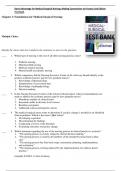Exam (elaborations)
Davis Advantage for Medical-Surgical Nursing: Making Connections to Practice 2nd Edition Test Bank by Janice J. Hoffman
- Course
- Institution
- Book
This isn't a book,a test bank is a collection of pre-written exam questions and answers designed to help educators assess and evaluate students' knowledge and understanding of course material. It serves as a valuable resource for creating quizzes and exams, saving instructors time and ensuring...
[Show more]



